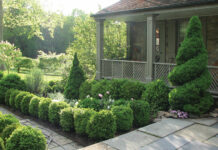
What’s scarier than blowing leaves for a client with an irate neighbor harassing you? Finding any of these fungi lurking in a lawn! In honor of Halloween, here are some of the best examples of Mother Nature’s dark sense of humor.
- Dead Man’s Fingers. “Dead man’s fingers is an apt moniker for a gruesome-looking fungus (Xylaria polymorpha and related species) that produces club-shaped fungal fruiting bodies that appear as fingers growing around the base of dying or dead woody plants,” writes Janna Beckerman in a recent Purdue Landscape Report. As if its appearance weren’t shocking enough, some species of the fungus cause an opportunistic black root rot on apple and crabapple, while others infect Norway maple, honey-locust, elm and pears. According to Beckerman, dead man’s fingers appear singularly or as clustered “fingers” about 1- 4″ high. In Spring, ascospores (sexual spores) are produced by the “fingers”, creating a bluish bloom on the tips of the fingers. Cutting into a finger reveals a white interior with black bubbles (gross!) that produce the ascospores. The “fingers” can release these spores for several months or years. The appearance of dead man’s fingers around or near the base of a susceptible tree may be indicative of a root rot problem. Unfortunately, by the time ‘fingers’ appear, the damage has been done to that area (roots, crown) of the tree. No fungicides are labeled for control of this disease and removing the ‘fingers’, while reducing overland spread of spores, doesn’t reduce the hyphae growing into the root system, warns Beckerman.When such trees are being removed, she writes, be sure to have the stump and large structural roots removed and/or ground down. Do not use infected wood for mulch to minimize the risk of spreading the fungus. When replanting, be sure to avoid planting other susceptible species in the same vicinity.

Stinky Squid Stinkhorn. Photo: Christine Menapace Stinky Squid Stinkhorn. How do I know about this one? Because it appeared in my own flower garden bed this past Summer! Formally known as Pseudocolus fusiformis, they showed up in the heat and humidity of August, emerging from my wood mulch, and resembling more a crab claw than a squid. Supposedly carrying an unpleasant odor, mine were luckily not too foul smelling. As a fungi, they’re difficult to eradicate, so I just let mine be. (I should note: no dogs or young children go in that garden in terms of poison risk.) Thomas Glasgow of the North Carolina Cooperative Extension, in an article on stinky squid writes, “If mushrooms and mushroom-like structures in the landscape are a problem for you, consider using less wood-based mulch and more pine straw; or consider frequent raking and disturbing of wood-based mulch beds.”

Devil’s tooth fungus. Photo: AdobeStock/Staffan Widstrand Devil’s Tooth Fungus. Hydnellum peckii has common names ranging from Bleeding Tooth to Strawberries and Cream, depending on the perspective of this fungus as grotesque or charming. It’s found under conifer trees, primarily in forested, often mountain areas most commonly found in the Pacific Northwest, but its range extends from Alaska to North Carolina, according to the blog, Mushroom Appreciation. The blog further states that it’s not entirely known how the fungus produces the peculiar red droplets, though it’s thought to be a form of transpiration. “The appearance of the Devil’s Tooth fungus is often an indicator of an old, species-rich forest. Its presence or absence can provide valuable information about the health of a forest ecosystem,” writes author Jenny.

Ghost pipe. Photo: Christine Menapace - Ghost Pipe–Not A Fungus! While not fungi, I’m including Ghost Pipe, or Monotropa uniflora, in this list because frankly, its name and unique characteristics make it perfect for this article. Also, I see this unusual plant fairly often on my hikes in the woods in NY and NJ. (According to the U.S. Forest Service, ghost pipe is found throughout the majority of the U.S. in humus in deep, shady woods at low to moderate elevations, but is noticeably absent throughout the range of the Rocky Mountains.) Other common names include Corpse Plant, or Indian Pipe. So what’s so cool about it? For one, it’s amycotrophic wildflower, which means it actually survives without chlorophyll,

Pinesap. Photo: Christine Menapace the essential green pigment that harnesses the sun’s energy for photosynthesis. Instead, it feeds off tree roots through fungi. It’s also said to have been used by Native Americans for its medicinal properties. I’ve also encountered its more rare cousin, pinesap, in my local woods.
And just so we’re not all completely creeped out by fungi, I’ll also post this recent photo I shot of spotted cort, or cortinarious iodes, sporting a perfect purple hue for Halloween. This fun mushroom showed up everywhere in my local woods after days and days of rain a few weeks ago. It’s among the fungi that are more fairy tale than fearsome!

Spotted cort. Photo: Christine Menapace For previous Halloween posts, see:
Protecting Your “Hallowed Ground” From Halloween Mishaps











![[VIDEO] Dickies®: Discover Workwear That’s Anything But Uniform](https://turfmagazine.com/wp-content/uploads/2023/06/1647663814-4b1a2a7742790a9b1e97a3b963477850192e1d6a9dfba9b07214a77bae25d6e3-d-218x150.jpg)

































![[VIDEO] Dickies®: Discover Workwear That’s Anything But Uniform](https://turfmagazine.com/wp-content/uploads/2023/06/1647663814-4b1a2a7742790a9b1e97a3b963477850192e1d6a9dfba9b07214a77bae25d6e3-d-324x160.jpg)